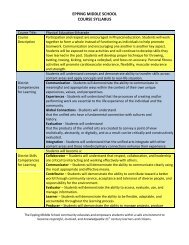Reading Standards for Informational Text & Literature - SAU 14
Reading Standards for Informational Text & Literature - SAU 14
Reading Standards for Informational Text & Literature - SAU 14
Create successful ePaper yourself
Turn your PDF publications into a flip-book with our unique Google optimized e-Paper software.
Grade Three<br />
<strong>Standards</strong><br />
Key Ideas and Details<br />
1. Ask and answer questions to demonstrate<br />
understanding of a text referring explicitly to<br />
the text as the basis <strong>for</strong> the answers.<br />
2. Recount stories including fables, folktales, and<br />
myths from diverse cultures; determine the<br />
central message, lesson, or moral and explain<br />
how it is conveyed through key details in the<br />
text.<br />
3. Describe characters in a story (e.g., their traits,<br />
motivations, or feelings) and explain how their<br />
actions contribute to the sequence of events.<br />
Craft and Structure<br />
4. Determine the meaning of words and phrases<br />
as they are used in a text distinguishing literal<br />
from nonliteral language.<br />
5. Refer to parts of stories, drama, and poems<br />
when writing or speaking about a text using<br />
terms such as chapter, scene, and stanza;<br />
describe how each successive part build on<br />
earlier sections.<br />
6. Distinguish their own point of view from that of<br />
the narrator or those of the characters.<br />
Integration of Knowledge and Ideas<br />
7. Explain how specific aspects of a text’s<br />
illustrations contribute to what is conveyed by<br />
the words in a story (e.g., create mood,<br />
emphasize aspects of a character or setting).<br />
8. (not applicable to literature) N/A<br />
9. Compare and contrast the themes, settings,<br />
and plots of stories written by the same author<br />
about the same or similar characters (e.g., in<br />
books from a series).<br />
Range of <strong>Reading</strong> and Level of <strong>Text</strong> Complexity<br />
10. By the end of the year, read and comprehend<br />
literature, including stories, dramas, and<br />
poetry, at the high end of the grades 2-3 text<br />
complexity band independently and<br />
proficiently.<br />
I can… Statements<br />
I can ask and answer questions to show I<br />
understand the text.<br />
I can retell stories and determine the main<br />
message (lesson or moral) and tell how it is shown<br />
in the text.<br />
I can talk about the characters’ traits, motivations,<br />
or feelings, and how they add to the events of the<br />
text.<br />
I can tell what the words and phrases mean and<br />
say if they are literal or non-literal.<br />
I can use words such as chapter, scene, and stanza<br />
when talking or writing about stories, dramas and<br />
poems.<br />
I can distinguish my point of view from that of the<br />
narrator or those of the characters.<br />
I can use illustrations to help me understand the<br />
words of the story.<br />
I can compare and contrast themes, setting and<br />
plots of stories written by the same author.<br />
I can read and understand complex literature<br />
independently and accurately.<br />
<strong>Reading</strong> <strong>Standards</strong> – In<strong>for</strong>mational <strong>Text</strong> and <strong>Literature</strong> Epping School District Page 11 of 16
















